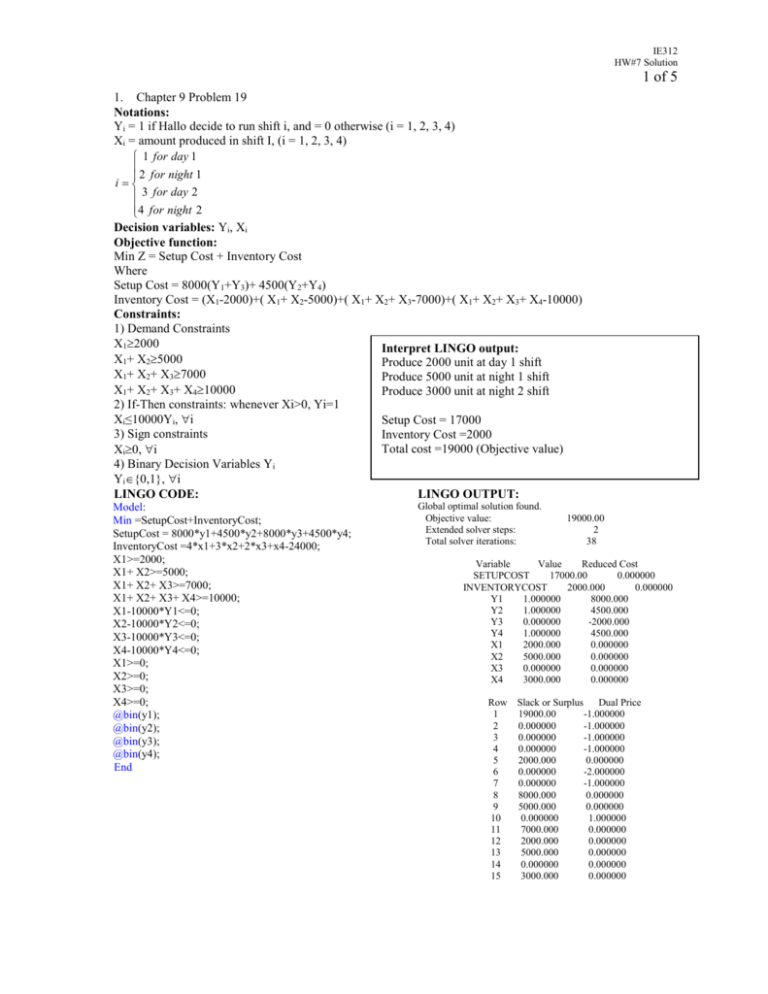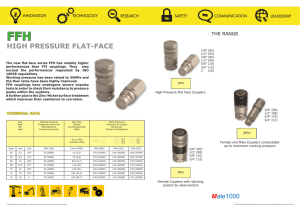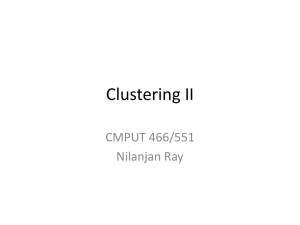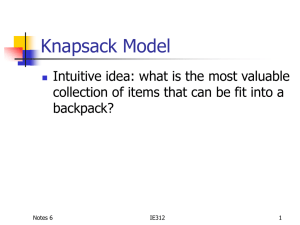x2 notation
advertisement

IE312
HW#7 Solution
1 of 5
1. Chapter 9 Problem 19
Notations:
Yi = 1 if Hallo decide to run shift i, and = 0 otherwise (i = 1, 2, 3, 4)
Xi = amount produced in shift I, (i = 1, 2, 3, 4)
1 for day 1
2 for night 1
i
3 for day 2
4 for night 2
Decision variables: Yi, Xi
Objective function:
Min Z = Setup Cost + Inventory Cost
Where
Setup Cost = 8000(Y1+Y3)+ 4500(Y2+Y4)
Inventory Cost = (X1-2000)+( X1+ X2-5000)+( X1+ X2+ X3-7000)+( X1+ X2+ X3+ X4-10000)
Constraints:
1) Demand Constraints
X12000
Interpret LINGO output:
X1+ X25000
Produce 2000 unit at day 1 shift
X1+ X2+ X37000
Produce 5000 unit at night 1 shift
X1+ X2+ X3+ X410000
Produce 3000 unit at night 2 shift
2) If-Then constraints: whenever Xi>0, Yi=1
Xi≤10000Yi, i
Setup Cost = 17000
3) Sign constraints
Inventory Cost =2000
Total cost =19000 (Objective value)
Xi0, i
4) Binary Decision Variables Yi
Yi{0,1}, i
LINGO CODE:
LINGO OUTPUT:
Model:
Min =SetupCost+InventoryCost;
SetupCost = 8000*y1+4500*y2+8000*y3+4500*y4;
InventoryCost =4*x1+3*x2+2*x3+x4-24000;
X1>=2000;
X1+ X2>=5000;
X1+ X2+ X3>=7000;
X1+ X2+ X3+ X4>=10000;
X1-10000*Y1<=0;
X2-10000*Y2<=0;
X3-10000*Y3<=0;
X4-10000*Y4<=0;
X1>=0;
X2>=0;
X3>=0;
X4>=0;
@bin(y1);
@bin(y2);
@bin(y3);
@bin(y4);
End
Global optimal solution found.
Objective value:
Extended solver steps:
Total solver iterations:
19000.00
2
38
Variable
Value
Reduced Cost
SETUPCOST
17000.00
0.000000
INVENTORYCOST
2000.000
0.000000
Y1
1.000000
8000.000
Y2
1.000000
4500.000
Y3
0.000000
-2000.000
Y4
1.000000
4500.000
X1
2000.000
0.000000
X2
5000.000
0.000000
X3
0.000000
0.000000
X4
3000.000
0.000000
Row Slack or Surplus
Dual Price
1
19000.00
-1.000000
2
0.000000
-1.000000
3
0.000000
-1.000000
4
0.000000
-1.000000
5
2000.000
0.000000
6
0.000000
-2.000000
7
0.000000
-1.000000
8
8000.000
0.000000
9
5000.000
0.000000
10
0.000000
1.000000
11
7000.000
0.000000
12
2000.000
0.000000
13
5000.000
0.000000
14
0.000000
0.000000
15
3000.000
0.000000
IE312
HW#7 Solution
2 of 5
2. Chapter 9 Problem 20
Same Notations and Decision Variables as #1
Objective function:
Min Z = Setup Cost + Inventory Cost
Where
Setup Cost = 1000(Y1+Y3)+ 3500(Y2+Y4)
Inventory Cost = (X1-2000)+( X1+ X2-5000)+( X1+ X2+ X3-7000)+( X1+ X2+ X3+ X4-10000)
Same Constraints as #1
LINGO CODE:
Model:
Min =SetupCost+InventoryCost;
SetupCost = 1000*y1+3500*y2+1000*y3+3500*y4;
InventoryCost =4*x1+3*x2+2*x3+x4-24000;
X1>=2000;
X1+ X2>=5000;
X1+ X2+ X3>=7000;
X1+ X2+ X3+ X4>=10000;
X1-10000*Y1<=0;
X2-10000*Y2<=0;
X3-10000*Y3<=0;
X4-10000*Y4<=0;
X1>=0;
X2>=0;
X3>=0;
X4>=0;
@bin(y1);
@bin(y2);
@bin(y3);
@bin(y4);
End
LINGO OUTPUT:
Global optimal solution found.
Objective value:
Extended solver steps:
Total solver iterations:
Interpret LINGO output:
Produce 5000 unit at day 1 shift
Produce 5000 unit at day 2 shift
Setup Cost = 2000< 17000 (Setup Cost form #1)
Inventory Cost =6000 > 2000 (Inventory Cost form #1)
Total cost =8000 (Objective value)
Compared result to #1
We see that the setup cost decreases while the inventory cost
increases The decrease in setup costs has actually raised
the average inventory level!
8000.000
3
24
Variable
Value
Reduced Cost
SETUPCOST
2000.000
0.000000
INVENTORYCOST
6000.000
0.000000
Y1
1.000000
1000.000
Y2
0.000000
-6500.000
Y3
1.000000
1000.000
Y4
0.000000
-6500.000
X1
5000.000
0.000000
X2
0.000000
0.000000
X3
5000.000
0.000000
X4
0.000000
0.000000
Row Slack or Surplus
Dual Price
1
8000.000
-1.000000
2
0.000000
-1.000000
3
0.000000
-1.000000
4
3000.000
0.000000
5
0.000000
-2.000000
6
3000.000
0.000000
7
0.000000
-2.000000
8
5000.000
0.000000
9
0.000000
1.000000
10
5000.000
0.000000
11
0.000000
1.000000
12
5000.000
0.000000
13
0.000000
0.000000
14
5000.000
0.000000
15
0.000000
0.000000
IE312
HW#7 Solution
3 of 5
3.
Chapter 9 Problem 22
“A job cannot be processed on machine j unless for all i<j the job has completed its processing on machine i.
once a job begins its processing on machine j, the job cannot be preempted on machine j.”
From above constraint, we know that job 1 has to be produced at M/C 1 first, and then M/C 3, and finally M/C
4, job 2 has to be produced at M/C 1 first, and then M/C 2, and finally M/C 4, and job 3 has to be produced at
M/C 2 first, and finally M/C 3. A summarize of machine order and the processing time for all job are shown
below.
Job
Machine Order
Processing time
1
1-3-4
P11=20. P31=25, P41=30
2
1-2-4
P12=15, P22=20, P42=18
3
2-3
P23=35, P33=28
Notations:
Pij is the processing of job j at machine i, i= 1.2.3.4 and j=1, 2, 3
Yij = Production starting time of job j at machine i
Fj = Flow time of job j
Note that
Flow Time of job j= Production Completion Time of job j at the last M/C the job has been produced–
Production Starting time of job j at the first M/C the job has been produced, and
Production Completion Time of job j at the last M/C the job has been produced = Production Starting Time of
job j at the last M/C the job has been produced + Processing time at the last M/C of the job
Decision variables: Yij
Objective function:
3
Min
F
j 1
j
/3
Where
F1 Y41 30 Y11
F2 Y42 18 Y12
F3 Y33 28 Y23
Constraints:
1) Type 1 Constraints
Y31 Y11 20
Y41 Y31 25
Y22 Y12 15
Y42 Y22 20
Y33 Y23 35
2) Type 2 Constraints
Y11 Y12 15 or
Y22 Y23 35 or
Y31 Y33 28 or
Y41 Y42 18 or
3) Sign Constrains
Fj,Yij 0, i,j
Y12 Y11 20
Y23 Y22 20
Y33 Y31 25
Y42 Y41 30
IE312
HW#7 Solution
4 of 5
4.
Chapter 14 Problem 5
Simulated Annealing (SA) for a single-machine scheduling problem with minimizing tardiness
Notation:
S0 is the best schedule found so far
(k )
(k )
(k )
(k )
(k )
(k )
Sk is the current schedule, Sk = ( j1 , j 2 ,, ji 1 , ji , ji 1 ,, j n )
G(Sk) is the tardiness of a schedule
Sc is the candidate schedule
Aspiration Criterion: G(Sk) G(S0)
Acceptance Criterion: If G(Sc) < G(Sk), accept Sc and let Sk+1 = Sc
If G(Sc) G(Sk), move to Sc with probability P(Sk+1, Sc) = ec/ k
c = G(Sk) - G(Sc)
Step 1:
Set k=1 and select the initial temperature 1,
To choose initial temperature 1 for Simulated Annealing, we will start with the 1 large number that later will
be slowly lowered in cooling steps. The value of 1 depends on maximum possible tardiness (worst schedule).
n
The worst case of the schedule is when all due date (dj) is equal to 0. We have 1=
P
j 1
j
Pj = Processing time of job j
(1)
(1)
(1)
(1)
(1)
(1)
Select an initial schedule S1 and set S0=S1= ( j1 , j 2 ,, ji 1 , ji , ji 1 ,, j n )
Step 2:
Select a candidate schedule Sc from N(Sk).
How to select a candidate depends on neighborhood structure.
Let us considered random pairwise job interchange as a type of schedule generation schemes. The schedule is
generated by randomly selecting any pair of distinct jobs within the schedule and exchanging their position.
(k )
(k )
(k )
(k )
(k )
(k )
Since Sk = ( j1 , j 2 ,, ji 1 , ji , ji 1 ,, j n ) , when exchanging position i with position i+1
(k )
(k )
(k )
(k )
(k )
(k )
we will have Sc = ( j1 , j 2 ,, ji 1 , ji 1 , ji ,, j n )
If G(S0)< G(Sc) < G(Sk), set Sk+1 = Sc and go to step 3
If G(Sc)< G(S0), set S0 =Sk+1 = Sc and go to step 3
If G(Sc) < G(S0), generate Uk~Uniform(0,1);
If Uk≤P(Sk, Sc), set Sk+1 = Sc; otherwise set Sk+1 = Sk; go to step 3
Step 3:
Select k+1≤k,
Let k = k+1, if k= N STOP; otherwise go to Step 2.
Note that as k decreases, the lower the probability to accept worse schedules.
IE312
HW#7 Solution
5 of 5
5. Chapter 14 Problem 8
For solving Knapsack problem, we learn that each decision variable must equal 0 or 1
Let Vi is the decision whether to put item i in the knapsack, where Vi = 1 if item i is put in the knapsack, = 0
otherwise (Vi {0,1}).
Notation:
X0 is the best schedule found so far
(k )
Xk = is the current knapsack decision, X k = (V1
,V2( k ) ,,Vn( k ) )
G(Xk) is the benefit obtained from the knapsack
Xc is the candidate schedule
Tabu Search (TS) combined with single complement moves:
Step 1:
Set k=1, select an initial solution X1 and set X0 =X1
( 0)
Start with a initial solution X0= (V1
,V2(0) ,,V j(0) ,,Vn(0) ) ,
Specify the length of tabu list as a fix length (L),
the length of tabu list (L) usually can be between 5 and 9.
Step 2:
Select a candidate solution Xc from N(Xk)
Using single complement moves to create the neighborhood solutions N(X k), selecting a position within the
schedule and change its value.
N(Xk) =
(V1(0) ,V2(0) ,,1 V j(0) ,,Vn(0) ) ,
For example:
X0=(1, 0, 0, 1, …, 1, …,0), with a single complement move we will have the set of
neighborhood solutions N(X0) as{(0, 0, 0, 1, …, 1, …,0), (1, 1, 0, 1, …, 1, …,0), (1, 0, 1, 1, …, 1, …,0), …., (1,
0, 0, 0, …, 1, …,0), (1, 0, 0, 1, …, 0, …,0), …, (1, 0, 0, 1, …, 1, …,1)}.
Candidate solution Xc= is the solution which is not tabu and has the best G(X k).
Let us assume Xc= (1, 0, 0, 1, …, 0, …,0) for example.
Enter Xc Xk on tabu list, which is the change of Vj to 1-Vj in this example.
Push all the other entries down (and delete the last one).
If G(Xc)<G(X0) set X0=Xc and go to step 3.
Step 3:
Let k = k+1, if k= N STOP; otherwise go to Step 2.









